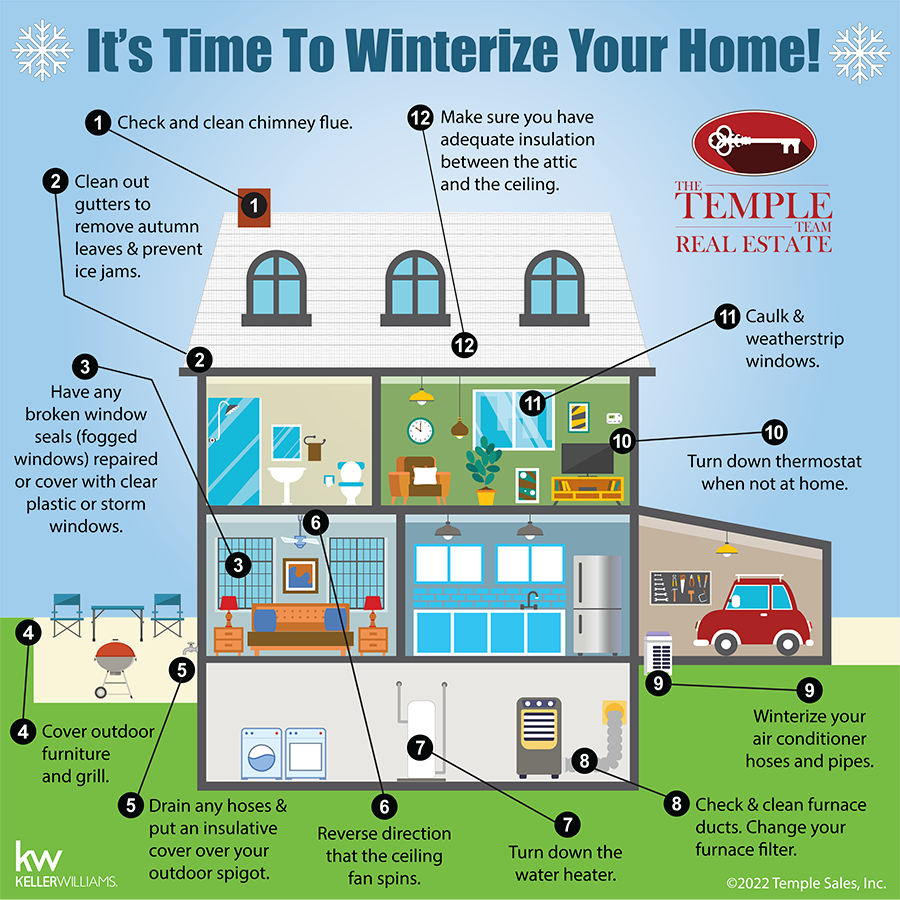As cooler temperatures arrive across North and South Carolina, it’s time to winterize your home. For most people, your home is your largest investment, so it’s important to maintain it to protect that investment. These handy home maintenance tips will help you get your home into shape.
- Check and clean the chimney flue if you have a fireplace. This is important if you have vented gas logs, and critical if you have a wood-burning fireplace to avoid adding to your risk of a house fire.
- Clean out gutters to remove the autumn leaves and prevent ice jams. The leaves can create drainage issues, making it easier for ice chunks to form once it gets below freezing. This can damage your gutter systems due to the extra weight, plus clogged gutters will no longer function properly to divert water away from your home’s foundation.
- If you have any broken window seals, it is advisable to have them repaired (an issue that is often indicated by fogginess between the layers of insulated glass). If you don’t have insulated windows (common in older and historic homes), it’s time to put up or close storm windows, or you can cover your windows with clear plastic, which adds an insulating air pocket. This will help your home hold heat better in the winter. Also, broken window seals is something homeowners commonly don’t get around to repairing over the years, and that can add up if it shows up on an inspection report when trying to sell your home in the future.
- Your patio needs attention in the winter as well. Cover outdoor furniture and your grill. They will last longer as this will keep them in better shape for warmer temperatures so you can enjoy them again in the spring and summer.
- Drain any hoses and store them away for winter. Once you have removed the hose, be sure to put an insulative cover over your outdoor spigot. These can typically be found in the plumbing section of your local hardware store. You don’t want your pipes to freeze and burst, and this is cutting off one avenue that chills pipes in the winter.
- Reverse the direction that the ceiling fan spins. Most fans have a small switch on the motor (just above the light) that you can switch to reverse the spin direction. In the summer, your fan should spin in a counter-clockwise direction to circulate the air. In the winter, operate the ceiling fan in a clockwise direction at low speed. The gentle updraft produced will force warm air near the ceiling back down into the habitable portion of the room.
- Turn down the water heater. This may seem counter-intuitive. Since the winter is cooler, you might wonder if you should turn up your water heater’s temperature. Most plumbers actually recommend against turning the water heater up in the South for winter. More temperate winters won’t cause your water to be as cold as it would be up North, so turning up your water temperature won’t provide you with any benefit. It also raises the chance you scald or burn yourself, or that you could overtax an older system by causing it to work harder. It is recommended that it should not be set above 120 degrees Fahrenheit for this reason.
- Check and clean furnace ducts. This should be a regular part of your seasonal HVAC maintenance, and should be done before temperatures get cold enough that the heat is on regularly. It is also recommended that you change your furnace filter to keep it working with efficiency.
- Another seasonal HVAC maintenance item is winterizing your air conditioner hoses and pipes. By keeping them properly insulated, you are less likely to have AC problems when warmer weather returns.
- Turn down the thermostat when not at home. This is a great money saver in the winter and if you have a programmable thermostat, you can go ahead and set it according to your typical routine so you can set it and forget it! Don’t turn the heat completely off though… keeping your home adequately warm is important for your water pipes. Also, if you have indoor pets, you will need to keep it at a high enough temperature they are still comfortable, though you can turn it down a little since their furry bodies can take the cold more easily than their human friends.
- To reduce warm air escaping and cold drafts coming in, caulk and weatherstrip your windows. Even if you did it last year, caulk and weatherstripping can deteriorate over time. This should be checked on annually and repaired/replaced as needed to make your home more energy efficient.
- Make sure that you have adequate insulation between the attic and the ceiling. Attics are ventilated, so can get quite cold in the winter. Insulation can get compressed over time and not work as efficiently, so needs to be refreshed sometimes over the years. If you have pull-down attic stairs, there are insulative products designed especially for that situation that can be found at your local home improvement store. For hatches and walk-in attic doors, you can add weatherstripping to the edges and tack foam-board insulation to the attic-side of the hatch piece or door to increase efficiency and reduce drafts.
We hope that you find these tips helpful. At The Temple Team, we’re not just here for you when buying or selling. We are your local resource and trustworthy advisor for all things related to home!





